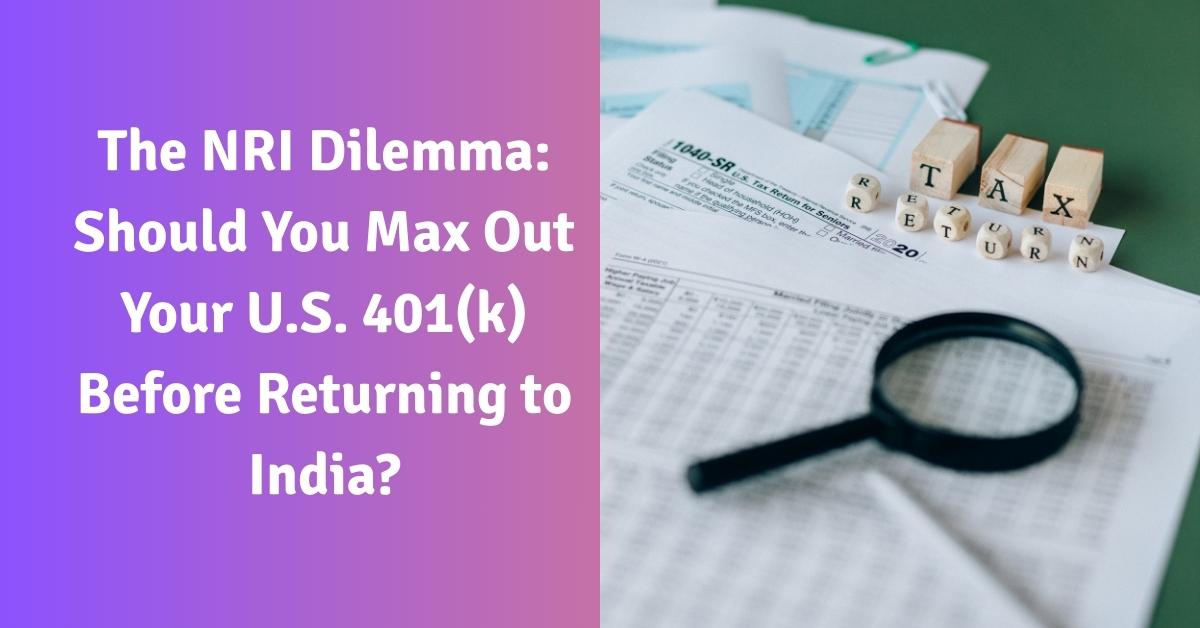The NRI Dilemma: Should You Max Out Your U.S. 401(k) Before Returning to India?

For many Indians working in the United States with plans to eventually return home, a critical financial question looms: does it make sense to maximize contributions to a 401(k) or IRA? This decision is far from simple, with compelling arguments on both sides. It’s a classic financial crossroads where tax benefits, long-term goals, and personal circumstances collide. There is no single correct answer, but by understanding the pros and cons, you can make an informed choice that aligns with your unique financial journey. This guide unpacks the key considerations to help you decide on the best strategy for your money and your future.
The Powerful Case for Maxing Out Your U.S. Retirement Accounts
The primary argument for contributing heavily to a 401(k) and IRA revolves around the immediate and substantial tax advantages offered by the U.S. Internal Revenue Service (IRS). Contributions to traditional 401(k)s and IRAs are tax-deductible, meaning they reduce your taxable income for the year, lowering your current tax bill. This is a powerful incentive, especially for those in higher tax brackets. Beyond the initial deduction, the money in these accounts grows tax-deferred. This allows your investments to compound over time without being eroded by annual taxes, a significant advantage over standard brokerage accounts.
Another compelling reason is the employer match. Many companies offer to match employee 401(k) contributions up to a certain percentage of their salary. This is essentially free money and a guaranteed return on your investment that you should never leave on the table. Failing to contribute enough to receive the full employer match is a common financial mistake. Furthermore, 401(k) and IRA accounts offer a wide array of investment choices, particularly in equities, which historically provide higher returns over the long term compared to more conservative fixed-income products available in India, like the Public Provident Fund (PPF).
The India Advantage: Favorable Tax Laws and Long-Term Diversification
Many NRIs worry about how their U.S. retirement funds will be treated once they return to India. Fortunately, a significant development has made holding onto these accounts more attractive. Section 89A of the Indian Income Tax Act, introduced in 2021, allows individuals to elect for tax deferral on income from foreign retirement accounts. By filing Form 10EE, you can ensure that your 401(k) earnings are not taxed in India until you actually withdraw the money. This aligns the taxation year in both the U.S. and India, preventing a scenario where India taxes the gains annually while the U.S. taxes them at withdrawal. This synchronization makes it possible to claim a Foreign Tax Credit (FTC) in India for the taxes paid in the U.S., effectively avoiding double taxation.
Beyond the tax benefits, keeping your 401(k) in the U.S. after returning to India is an excellent strategy for portfolio diversification. The U.S. and Indian economies are two of the world’s strongest, and having investments in both markets reduces country-specific risk. Indian Foreign Exchange Management Act (FEMA) regulations permit you to retain and manage these overseas assets even after becoming an Indian resident. This U.S.-based nest egg can serve as a long-term retirement goal, a fund for future international expenses like buying property abroad, or simply a way to hedge against currency fluctuations.
When to Hit Pause: Reasons to Not Max Out Your 401(k)
Despite the strong arguments in favor, blindly maxing out your 401(k) is not always the right move. A 401(k) is a long-term, relatively illiquid investment. Before locking up a significant portion of your income, it’s crucial to build a solid financial foundation. If you have high-interest debt, such as credit card balances or personal loans, your priority should be paying those off. The interest you save will almost certainly outweigh the investment gains from your 401(k).
Similarly, you must have an emergency fund in place. Financial experts recommend having at least six months’ worth of living expenses saved in an easily accessible account. This fund acts as a safety net for unexpected events like job loss or medical emergencies, preventing you from having to dip into your retirement savings prematurely. Ensuring you have adequate life, health, and disability insurance is another prerequisite. Finally, if you anticipate major near-term expenses, such as a down payment for a house or funding a new business, it may be wiser to keep that money liquid rather than tying it up in a retirement account.
Building Your Personal Strategy: A Balanced Approach
Since there’s no one-size-fits-all solution, the best approach is a phased and personalized one. For those in the early years of their career in the U.S., the primary focus should be on covering the essentials. This means building an emergency fund, clearing high-cost debts, getting insured, and contributing just enough to your 401(k) to receive the full employer match. Anything over and above the employer match can be considered once these foundational pillars are secure.
As your income grows and your financial situation becomes more stable, you can then consider increasing your contributions to max out your 401(k) and IRA. When deciding between the two, evaluate your 401(k) plan’s fees and investment options. If the fees are high or the choices are limited, you might prefer to contribute up to the employer match in your 401(k) and then direct surplus funds to a traditional IRA, which often offers more flexibility. For those planning to return to India, a traditional 401(k)/IRA is generally preferable to a Roth account, as the tax benefits under Section 89A are more clearly applicable to traditional, pre-tax accounts.
Aligning Investments with Your Global Goals
Maximizing your 401(k) isn’t just about contributing; it’s also about investing wisely within the account. Your investment choices should align with your overall asset allocation strategy and long-term goals. With a long time horizon before retirement, a significant portion of your 401(k) should ideally be allocated to equities to harness the power of long-term growth. It’s also crucial to be wary of advice from commission-based agents in India who may push you to invest in Indian products like mutual funds. Due to the U.S.’s Passive Foreign Investment Company (PFIC) rules, investing in Indian mutual funds while being a U.S. resident can lead to complex and punitive tax consequences. A better approach is to first maximize U.S. tax-advantaged accounts and then, if you have surplus funds, invest in U.S. stocks or ETFs, some of which can provide exposure to the Indian market without the PFIC headache.
Conclusion
The decision to max out your 401(k) or IRA while in the U.S. is a deeply personal one, contingent on your individual financial health, job stability, and long-term aspirations. The tax deductions and tax-deferred growth, amplified by employer matches, present a powerful case for aggressive saving. New Indian tax laws have further sweetened the deal, making it feasible to avoid double taxation and use these funds as a long-term, diversified asset. However, this strategy should not come at the expense of financial stability. Prioritizing debt repayment, building an emergency fund, and securing adequate insurance are non-negotiable first steps. By adopting a thoughtful, phased approach and aligning your strategy with your personal goals, you can navigate this complex decision and build a secure financial future, no matter which continent you call home.
FAQs
- What is the biggest benefit of contributing to a 401(k) in the U.S.?
Ans- The biggest benefits are the immediate tax deduction on your contributions, tax-deferred growth of your investments, and the potential for a company match, which is essentially free money.
- How will my U.S. 401(k) be taxed in India after I move back?
Ans- Under Section 89A of India’s Income Tax Act, you can elect to defer Indian taxes on your 401(k) income until you withdraw it, which helps you claim a Foreign Tax Credit and avoid double taxation.
- Should I keep my 401(k) funds in the U.S. after I return to India?
Ans- Yes, keeping the funds in the U.S. is a great way to maintain a diversified investment portfolio, and Indian FEMA regulations allow you to do so.
- When is it a bad idea to max out my 401(k)?
Ans- You should prioritize paying off high-interest debt, building a six-month emergency fund, and getting adequate insurance before you focus on maxing out your 401(k).
- What is the absolute minimum I should contribute to my 401(k)?
Ans- You should contribute at least enough to get the full employer match, as this is a 100% return on your investment.
- Should I choose a Traditional or Roth 401(k) if I plan to return to India?
Ans- A Traditional 401(k) is generally preferred because the Indian tax deferral benefit under Section 89A is more clearly aligned with pre-tax retirement accounts.
- Why should I avoid investing in Indian mutual funds while living in the U.S.?
Ans- Due to the U.S. PFIC (Passive Foreign Investment Company) rules, investing in Indian mutual funds can lead to very complicated and unfavorable tax reporting and obligations.
- Can I access my 401(k) money before the official retirement age?
Ans- Yes, there are provisions for penalty-free early withdrawals for specific reasons like qualified education expenses, certain medical expenses, and a first-time home purchase, though income tax would still apply.
- What’s a better investment: my company’s 401(k) or a personal IRA?
Ans- First, contribute to your 401(k) up to the employer match. For additional savings, compare your 401(k)’s fees and investment options to an IRA’s. If your 401(k) has high fees or poor choices, an IRA might be a better option for funds above the match.
- What is the most important first step in financial planning for an NRI?
Ans- The most important first step is to establish a solid financial foundation: create an emergency fund, pay off high-interest debt, and ensure you are properly insured.
Disclaimer: The information provided here is for educational and informational purposes only and should not be construed as financial, legal, or tax advice. Consult with a qualified professional before making any investment decisions. We do not accept any liability for errors or omissions in this information nor any direct, indirect, or consequential losses arising from its use.



